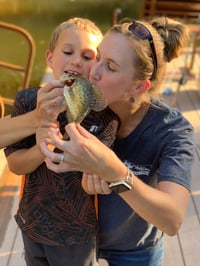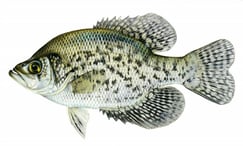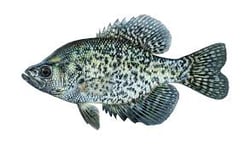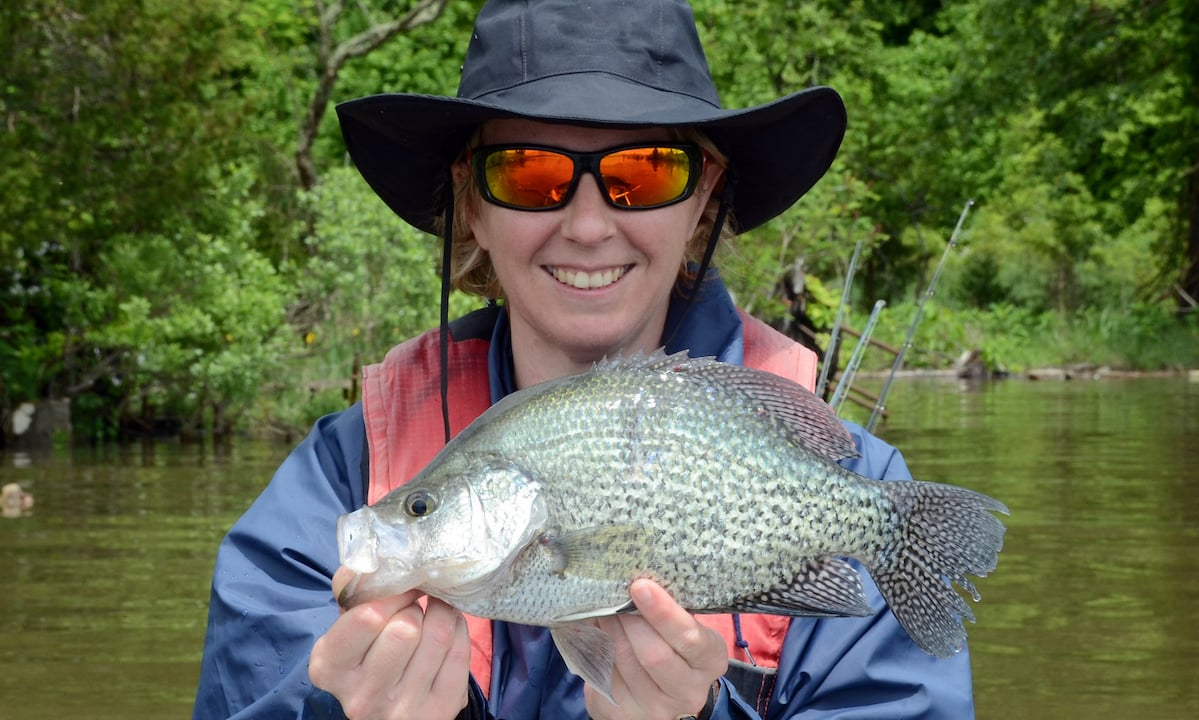Crappie are a great sportfish to stock, but you should understand all the reasons you may or may not want to include them in your Largemouth Bass fishery before you add them to your stocking plan.
Why Crappie are so Popular for Stocking Private Ponds

Behind Largemouth Bass, Crappie are the second most requested sportfish to be stocked here at Pond King, and it's easy to see why!
Crappie tend to have more of a schooling nature compared to Bass, they put up a heck of a fight when caught on light tackle, they are a great fish to start novice fishermen on, and they make great table fare.
With all these positive attributes, you might ask yourself why we don't include Crappie in all of our stocking packages.
So, let’s answer that for you.
The Difference Between White, Black and Hybrid Crappie
For starters, let's go over the various species of Crappie and their typical habitat preferences.

White Crappie
White Crappie are by far the most prolific of all the different species.
A large White Crappie female can produce upwards of 60,000 eggs per ¼" of length during the spawning season. While it is sometimes hard to distinguish between species using visual factors, White Crappie typically have "barring" that runs vertically down their body.
Therefore, the more accurate way of distinguishing between the species is to count the number of hard (sharp) dorsal rays. White Crappie have 5-6 hard rays on their dorsal fin. This Crappie species is more of a riverine species and can better handle turbid water conditions.

Black Crappie
Another species is the Black Crappie.
These fish also have a sizable reproductive capability, but less than the White Crappie. The variation in dark and light scale patches on the sides of their body doesn't make a distinguishable pattern, so the best way to identify them is to count their hard dorsal rays; if they are a Black Crappie, they'll have 7-8 hard rays.
Additionally, this species prefers less turbid water associated with backwater sloughs, ponds, lakes, and reservoirs.

Hybrid Crappie
The other species is the Hybrid Crappie.
Hybrid Crappie are a cross between the White and the Black Crappie. The coloration and hard dorsal ray count for these hybrids are more similar to the Black Crappie. While this hybridization can occur in the wild, it is most typically done in aquacultured settings.
The primary purpose for this cross is that these fish exhibit the same growth and natural behaviors as the parent species but have a significantly reduced reproductive rate.
Pond Management Requirements for Crappie
With all of that being said, the common biological factor between the Black and White Crappie is their high reproductive capability.
These fish require a high annual harvest level to keep their population numbers in check, which is the primary reason we don't include them in all our stocking packages.
Avoid Stocking White Crappie in Small Ponds
In fact, we rarely recommend any Crappie for ponds less than 3 acres, and we almost never stock or recommend White Crappie for any private fishery. If they make their way into your fishery, it is most likely from being washed in from nearby streams or rivers.
While still having a high fecundity, Black Crappie are better suited for "large" private ponds or lakes because smaller ponds can't produce adequate forage resource availability for two predator species.
(See our post about what type of fishery your pond can support for more information)
Additionally, any fishery supporting Bass and Crappie needs to have a heavy population density of smaller (10-14") predators that will prey on juvenile Crappie, helping to keep their population density in check.
Generally speaking, ponds or lakes need to be at least 3-5 acres or larger to fit this bill, and, even then, you'll need to increase management efforts on annual harvests.
Smaller Private Ponds Should Only Consider Hybrid Crappie
If you have a smaller pond, you'll only want to consider stocking Hybrid Crappie.
Their lower reproductive rate caused by the hybrid heterosis makes this species "easier" to manage. But you will still need a healthy annual harvest to keep growth rates up and the bulk of the population within the desired size range.
Competition for Resource Availability between Crappie and Bass
Another factor that prevents Crappie from being recommended for stocking is if the primary goal of the lake is trophy-class Bass production.
A trophy-class Largemouth could easily consume a 10" Crappie, but getting that Bass to that point is the problem you'll have.
If your fishery goal is trophy Bass, you'll want to increase the density of the largest Bass possible in the shortest amount of time. The primary drivers of this are high forage resource availability and limited competition.
Largemouth Bass and all species of Crappie are in direct competition for resources, whether that be forage or habitat availability.
In a setting with limited resource availability, that can increase the time it takes for you to reach your goals. It simply comes down to which are you more interested in, raising trophy-class Bass or diversifying your fishing experience.
Contact Pond King for Fish Stocking and Pond Management
Before stocking Crappie, we recommend a site assessment, forward-thinking, and re-evaluating your fisheries goals.
However, if you are willing to put in the work to maintain a healthy population density and are ok with slightly slower Bass production, there is a stocking option for you. If you have any questions about stocking Crappie to find out if they are a good fit for your fishery, feel free to contact us anytime or call the Pond King fisheries biologists today!
See y'all down at the pond!




